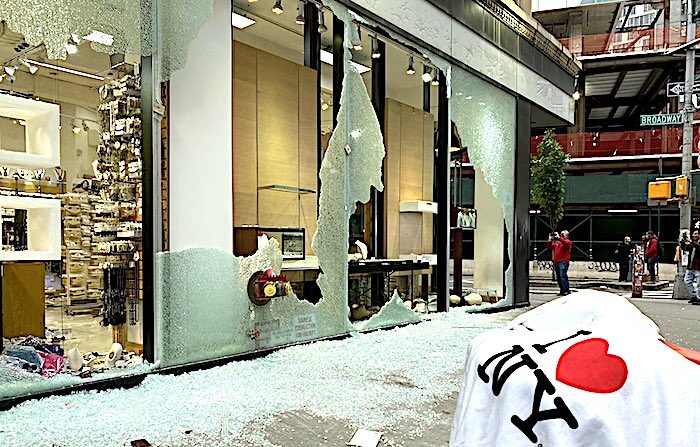The mobs seemingly pillaged at will. Many were caught on tape, some with their faces visible. Others even posted on social their own videos of their actions those nights.
"We got the Rolex store," some in the crowd can be heard screaming in one video. Police were far outnumbered and seemingly unprepared.
Hundreds of arrests were made during the looting and riots. Many of those arrests took place in Manhattan and along some commercial streets in the Bronx where the problems were widespread. Surveillance videos show looters breaking into many locally owned Bronx stores, stores that were left ransacked.
NYPD data reviewed by the NBC New York I-Team shows 118 arrests were made in the Bronx during the worst of the looting in early June.
Since then, the NYPD says the Bronx DA and the courts have dismissed most of those cases - 73 in all. Eighteen cases remain open and there have been 19 convictions for mostly lesser counts like trespassing, counts which carry no jail time.
Jessica Betancourt owns an eyeglass shop that was looted and destroyed along Burnside Avenue in the Bronx last June. "Those numbers, to be honest with you, is disgusting," Betancourt said when told of the few cases being prosecuted.
Betancourt is also vice president of a local merchants association. She says local business leaders are upset few are being held accountable for the destruction they caused. "I was in total shock that everything is being brushed off to the side."
In Manhattan, many major retailers and local shops were broken into in late May and into June. Amid the pandemic, mobs and organized criminals were taking advantage of huge protests rocking the city after the Minneapolis police killing of George Floyd.
In Manhattan, the NYPD data shows there were 485 arrests. Of those cases, 222 were later dropped and 73 seeing convictions for lesser counts like trespassing, which carries no jail time. Another 40 cases involved juveniles and were sent to family court; 128 cases remain open.
Law enforcement expert and former NYPD Chief of Patrol Wilbur Chapman voiced anger at the DA's dropping of so many looting and burglary cases. "If they are so overworked that they can't handle the mission that they're hired for, then maybe they should find another line of work," Chapman said.
Sources in the DA's offices tell NBC New York that evidence, in some cases, was simply not strong enough for proof beyond a reasonable doubt. And with the courts closed amid the pandemic, there was a huge backlog of cases was unwieldy for both the courts and prosecutors.
The NYPD did set up a task force after the riots to examine videos and photos to separate out suspected rioters from peaceful protesters. That work shares similarities with what the FBI is doing in making hundreds of arrests after the riot at the U.S. Capitol.
But unlike federal prosecutors who are moving forward with prosecutions of the Capitol Hill rioters, New York City prosecutors are disposing of most burglary-related cases.
The NYPD says there was tedious follow-up investigations led in part by Deputy Inspector Andrew Arias, where evidence included photos and recovered stolen property.
"We had to analyze each case individually and see if, in fact, we could prove the right person had committed the crime," Arias said.
Former Chief Chapman says while the NYPD did some follow-up, he said the data shows the district attorneys and the courts have not. "It allowed people who committed crimes to go scot free," Chapman said.
Bronx DA Darcell Clark declined repeated requests for an interview, as did Manhattan DA Cy Vance, whose office has been busy with a team of prosecutors investigating separate allegations of tax fraud surrounding President Trump's businesses - allegations Trump denies.
In an internal memo, Vance says there were over 600 commercial burglary arrests in addition to over 3,500 unindicted felony cases in the pipeline waiting to move forward in the courts. His memo says all those cases were on hold because of the pandemic.
Before dropping a case, Vance told his prosecutors to review defendants' criminal histories, whether police could really place the suspect at the scene, and whether the individual caused "any damage to the store."
Vance told his office,
"For many of these commercial burglaries, you will be asked to reduce the initial felony charge to a misdemeanor and to dispose of the case ... with an eye towards rehabilitation. The continued goal is to achieve consistency and equitable treatment in these cases."A court spokesman, Lucian Chalfen, says decisions to dismiss cases were primarily made by the district attorneys:
"An application must be made by the district attorney or as they have done with hundreds of DATs, decline to prosecute them."In the Bronx, some businesses that had insurance are back. But the scars from the riots of a year ago remain.
"They could do it again because they know they won't get the right punishment," Betancourt said.




Comment: A confluence of means, motives and circumstances provided the ideal environment for mayhem and destruction - a known and calculated scenario set in motion with potential to repeat. The eve of destruction may become a very long night.